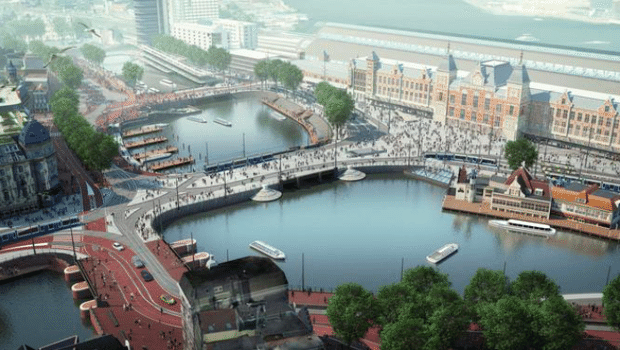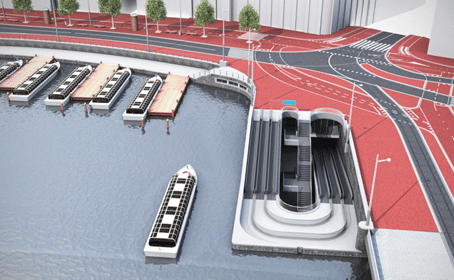Amsterdam Is Flooding, On Purpose
Published on by Water Network Research, Official research team of The Water Network in Government
In Amsterdam, asphalt is out and water is back. Widened canals—and underground bike parking—will bring the city’s Central Station a little closer to nature and history.

The Central Station area as it should appear in 2020. (Gemeente Amsterdam)
Thanks to a redesign of the area around the Dutch capital’s Central Station, road space will be cleared away to allow for wider waterways. This will strip away some of the area’s concrete cladding to make the terminus site look once more like what it actually is—an island in the city’s harbor. The revamp should help to restore a little of Amsterdam’s maritime character—especially as this site, known locally as The Entree, has long been a key arrival point for Amsterdam.
The extra water is just the tip of the iceberg; it really will contain much more beneath the surface. The ground beneath the station is being excavated to accommodate a new metro stop, which will extend into chambers under the canals and lake that surround it. In what could be the most Dutch urban twist ever, these chambers won’t solely be used for metro lines, shops, or storage. Mainly, they’ll be filled with bikes.
The intriguing plan, which CityLab first reported on back in 2015, sees Amsterdam struggling to make up for its lack of bike parking spots. In a city where 63 percent of citizens cycle daily, you can’t just leave people to chain their bikes to railings or lampposts without clogging the streets. Last year, Amsterdam confiscated almost 64,000 bikes, many of which (although not the majority) had been left in places where they obstructed the footpath or the roadway.
To make space for commuters’ bikes, the already densely built city has to find more space. The answer, they’ve decided, is to create floating bike parking pontoons around the central station, as well as to excavate below the canals to create more places to stow two-wheelers. By 2023, when the Central Station revamp is complete, there will be space for 17,500 bikes here, rising to 21,500 in 2030 when the bike islands are complete.

Part of the new roadway layout (Gemeente Amsterdam)
For some time Amsterdam has been turning itself back out to face the open water. The city’s docks—wonderfully wide and windswept in a city otherwise characterized by miniaturist intimacy—are now one of the key sites for new housing in the city, while new residential islands continue to rise from the waters of the IJmeer.
As sea levels rise globally, it seems healthy both practically and psychologically for this most aquatic of cities to allow space for the waterways that allowed it to exist in the first place.
Read more at: City Lab
Media
Taxonomy
- Integrated Urban Water Management
- Environment
- Urban Water
- Integrated Infrastructure
- Spatial Planning
- Architecture
- Landscape & Urban Design
- Eco-City Development
- City
- Urban Design